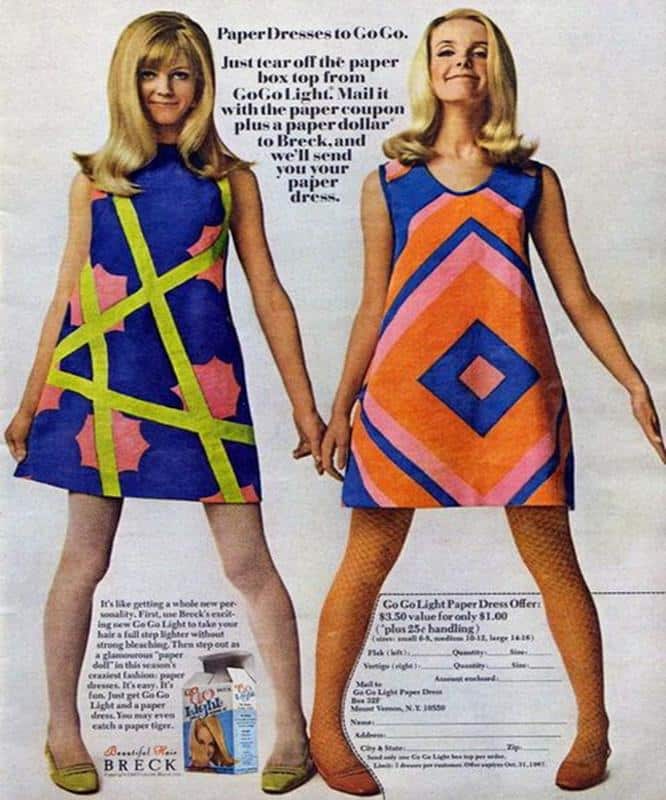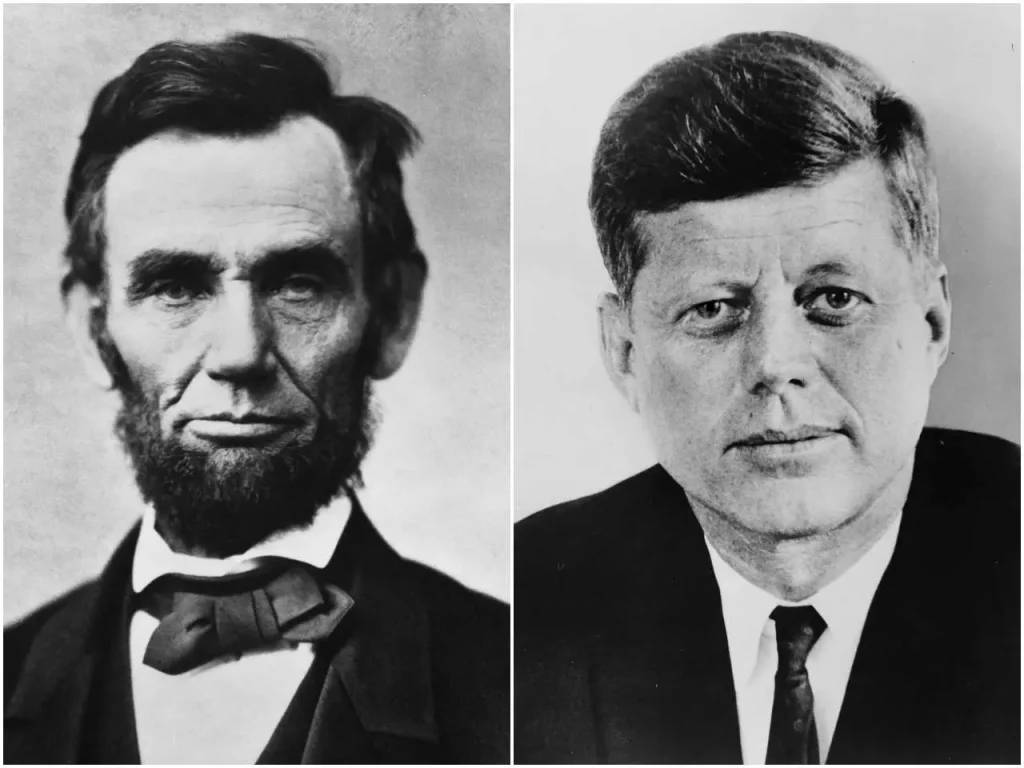Few historians would disagree that the 1960s was the most culturally significant decade in American history—particularly in terms of American Pop culture.
From the signing of the Civil Rights Act of 1960 to Woodstock (the biggest music festival in history, held in 1969), the 60s were a veritable roller-coaster ride of cultural evolution and revolution.
The Vietnam War, “Black Power,” the “Hippie” counterculture, the “pill,” “sit-ins” and protests, the Kennedy and King assassinations, the Beatles, the Kent State massacre, Star Trek, the “Summer of Love,” long hair and bell bottoms, and Rolling Stone magazine—opened America’s eyes (as well as much of the world’s) to realities and possibilities never before imagined; some good, some bad, some on the verge of absurd.
Case in point: the paper dress. One of the boldest fashion statements of the decade.

Toilet Paper and Hospital Gowns
In the spring of 1966, the Scott Paper Company, one of the leading manufacturers of household paper products, launched a magazine ad campaign promoting its colorful new line of bathroom tissue, paper towels, napkins, and other paper products. For a few “proof-of-purchase” tags, customers could redeem a mail-order coupon and receive an absurd new product: a paper dress.
Appearing in the April 29, 1966 issue of (now defunct) Life Magazine, the ad offered two fashion options: a black-and-white “Op Art” print dress, and a red Paisley bandanna pattern–either dress for the preposterously low price of $1.25 (including shipping).
Although wearable paper items were already in regular use (crepe paper costumes, medical exam gowns, fast-food employee counter hats), they weren’t previously offered as mainstream fashion. And despite the seeming absurdity of paper dresses, Scott’s “Paper Caper” dresses were a surprise hit–and by year’s end, the company had filled nearly half a million orders.
As “hip” young women clamored to own these inexpensive paper dresses, several other paper companies jumped on the disposable clothing bandwagon; offering paper shifts advertising their favorite political candidates, candy bars, or dresses featuring “groovy” patterns and avant-garde photographic images.
But while Scott’s (and their competitors’) paper dresses were an unqualified success, it didn’t happen over night.
Duraweave
In the 1950s, a number of paper product companies (Scott, Kimberly-Clark) began experimenting with reinforced cellulose (plant fiber used to make paper, artificial cloth, and plastic) to make their products more durable and, perhaps, reusable.
Kimberly-Clark (the makers of Kleenex tissue and Kotex menstrual pads) had already developed Cellucotton (a paper product with a high concentration of Rayon-reinforced cotton) decades before, but had now created a new, stronger version made from Nylon-reinforced cellulose called Kaycel, intended to be marketed for hospital gowns and radiation suits. Similarly, Scott Paper Company had come up with their own stronger cellulose-based paper called Duraweave–consisting of Rayon scrim (a web-like product) sandwiched between two layers of cellulose fiber.
But neither manufacturer initially considered using their new, stronger paper products to enter the highly competitive fashion clothing market. In fact, both companies hesitated to even use the term “paper” in relationship to their products for fear that consumers (primarily women) would equate “paper” with “flimsy.”
But both manufacturers misjudged the mindset of the 1960s American woman.
Brainstorm
In 1965, an engineer for Scott became fixated on an idea that others of the industry were disinclined to consider: production and marketing of clothing made from . . . paper.
Enlisting his wife’s help, the engineer had her design a mock-up of a basic “A-line” dress made of Duraweave that could be presented to potential department-store buyers. Though far more durable than the company’s paper towels, these garments were, nonetheless, paper—and intended to be discarded after a couple of wears.
Department-store buyers, however, weren’t interested. Like the paper companies, they feared women would equate “paper” with “flimsy”–which could effect over-all business and negatively impact their image. But once word of the public’s reaction to the Life Magazine ad began to spread, and they saw the garments being worn on the streets, retailers regretted their decision—and did a quick about-turn.
But what was the attraction to paper dresses?
The Mod Connection
Between the “Beat” (Beatnik) Generation of the late 1940s and 1950s (centered in Greenwich Village, New York City), and the “Hippie” counterculture of the mid-1960s (based in New York City and San Francisco, California), rose the “Mod” subculture of the late 50s and early 60s, imported from London, England.
A product of the so-called “British Invasion” (the musical movement that introduced the Beatles, Jerry and the Pacemakers, the Rolling Stones, Donovan, and the Animals to America), the “Mods” influenced music, fashion, and social attitude.
Unlike the “Beats” (or the Hippies to follow), the “Mods” were known for zipping around town on motor scooters, taking amphetamines, their preference for R&B (or Jazz) music, and hanging out in all-night coffee bars; cafes featuring juke boxes.
But above all, “Mods” were known for the way they dressed.
Men wore stylish, neo-Italian, effeminately styled jackets and pants, while women wore very colorful (psychedelic, Op-Art, Paisley prints, striped or with wild geometric shapes) mini or “A-line” dresses—sometimes with knee-high “go-go” boots. These fashion aesthetics were popularized in the US by British Rock bands like the Who and Small Faces, singers like Petula Clark, and fashion icon, Twiggy.
But what made the “Mod” aesthetic most beneficial to American manufacturers of paper dresses was the women’s rejection of tailored clothes–in favor of inexpensive, off-the-rack fashions.
Scott Paper Company’s paper dresses were priced right, fit the “Mod” design aesthetic, and had one element British fashions didn’t: they were seen as futuristic. It was easy to imagine women of the future wearing paper garments purchased on rolls like wrapping paper that they could wear once or twice and toss away.
But, were paper garments truly futuristic? Or were they, in fact, retro?
Ancient Eastern Culture
The earliest known production of paper clothing began in the 2nd Century CE, in ancient China—prior to paper being used for writing.
Made from washi paper (a light-weight and durable paper made from tree bark, bamboo, and rice straw), various types of paper garments were developed by the Chinese through the centuries; the craft slowly spreading throughout Asia until it reached Japan in the 10th Century.
From the 10th Century forward, Japanese craftspeople produced paper garments called “kamikos,” white ceremonial robes wore at special events such as the O-mizutori Festival. Kamiko crafting became a traditional Japanese artform of the Shiroishi and Miyagi regions of Japan, carried out to meticulous standards during the Edo Period (1603-1868).
Paper garments were never sold commercially in China nor Japan, but something more akin to being tailor-made to the individual; those of Japan’s Edo Period considered works of art today.
Post-WWI
In the wake of WWI, wore-torn Europe suffered many shortages including wool and other everyday textiles; nowhere more so than Germany and Austria. Out of sheer necessity, clothing manufacturers developed cloth from the one thing they had in abundance: paper.
In a January 1917 edition of the New York Sun, an article noted that the Germans had devised paper-based threads for making “sacks and bags, girdles, doilies, aprons, and working garments,” as well as dresses and other garments. The article explained that “The inventors have discovered a way to give the ‘paper cloth’ great resistance to dampness.” At that point, the Germans were manufacturing certain elements of military uniforms out of paper–including those worn by submarine crews and pilots.
By 1920, German- and Austrian-made paper clothing was being produced and exported to Turkey, Italy, and England (where in London, a German-made paper suit could be purchased for $.46 to $1.95, meaning men could buy a new suit each week of the year for less than the cost a single British-made wool suit).
Drawing the attention of the American Commerce Department’s Bureau of Foreign and Domestic Commerce, the Bureau imported a selection of Austrian paper suits to explore the possibilities presented by paper clothing.
Exhibiting them around the US to gauge public appeal (and give American clothing manufacturers an opportunity to see their competition) the AP (Associated Press) reported that the suits were, “warm, comfortable and durable, considering the fabric of which they are made, and not liable to tear or go to pieces when wet . . . and could be sold for about $.15.”
When similar paper garments were finally made available in the US, the most popular were men’s suits; which came in a selection of 50 different styles and sold for a mere $.60 each. What’s more, these suits had the novel feature of being able to be dry cleaned with an eraser! (A 1920 news photo depicted three smiling women modeling paper suits said to cost from $.25 to $.50.)
The following summer, a female beachgoer was photographed for a Chicago newspaper modeling a $1.50 bathing suit created by a local paper clothing manufacturer, the caption reading, “[The suit] has withstood surprisingly well all tests for rough treatment and water wear.”
By that fall, the manufacturer was offering a complete line of paper suits, dresses, and accessories– including women’s hats (of “imitation straw and cloth [that] defies detection,” complete with paper feathers), men’s shirt collars, and neck ties.
By the mid-1920s, however, the paper clothing novelty had worn off; partly due to paper shortages, but mostly because of America’s new post-war prosperity. (Successful men did not want to be seen in a $.60 suit; their wives wanting to reflect their husband’s success.)
Mars of Ashville, Andy Warhol, and JCPenney
Hot on the heels of Scott Paper Company, in June of 1966, hosiery company Mars of Asheville launched their own line of paper fashions under the subsidiary label, Waste Basket Boutique.
Not only did Mars offer colorfully-printed dresses in different styles and prints, they sold a variety of so-called “space age” foil clothing as well. Two months later, they added a line of white dresses that came complete with watercolor paint sets consumers could use to personalize them.
Mars’ biggest coup, however, occurred when world-famous Pop artist Andy Warhol agreed to contribute art work to help promote a new line of Pop-art dresses: Campbell’s Vegetable Soup ‘Souper’ Dress (inspired by his iconic 1962 artwork, Campbell’s Soup Cans).
Soon, Mars of Asheville was the leading manufacturer of disposable fashion in the US, producing 80,000 garments per week—which were soon found on the shelves of some of the biggest retainers in America, including JCPenney.
Paper and Presentations
As the paper dress phenomenon reached new heights of acceptance, paper fashion became the focus of exhibitions, magazine spreads, and Haute couture designers.
Between April and October of 1967, Expo 67, held in Montreal, Canada, featured paper clothing in the “Pulp and Paper Pavilion.” In June of that year, (now defunct) Mademoiselle magazine ran the cover story, “The Big Paper Craze,” highlighting some of the innovative and alternative takes on paper fashion including brimmed hats made of paper, “smart smocks” produced from knitted paper yarn, ladies’ bedroom slippers, string bikinis, and a dress that could be “wiped down and ironed for repeated wear.”
For a 1967 fund-raising dinner for the Police Athletic League in NYC, attendees commissioned opulent paper dresses from American couturiers Ferdinando Sarmi and Bill Blass–whose cheetah-print brown paper dress sported cuffs embellished with genuine sable.
Keeping in step with the times, iconic French Haute couture designers Pierre Cardin and Hubert de Givenchy, as well as Spanish-born fashion designer Paco Rabanne, each created a selection of paper clothing for various high-society figures. Even the Duchess of Windsor, a main-stay on “Best-Dressed” lists throughout Europe, wore a paper dress; emphasizing that paper clothing can be worn by anyone of any social status.
In January of 1968, the Museum of Contemporary Crafts in Manhattan, NYC, presented an exhibit titled, “Made With Paper,” showcasing paper clothing (including several dresses, shirts, hats, and a “shaggy” paper coat) designed by American designer Bonnie Cashin, who launched a paper clothing line that same year titled, Paper Route to Fashion. Cashin had been interested in the possibilities paper presented since the early 1950s, designing paper handbags even then.
One of the most unusual paper dresses of the era was designed for the Paraphernalia boutique (founded in New York City in 1965), whose fashion-forward designs by American designers Betsey Johnson, Diana Dew (and others), were among the few American challengers to the innovative London fashion designers.
Johnson’s stand-out dress was made from soft blotting paper impregnated with seeds that would immediately flower when the dress was moistened. (As with many of Paraphernalia’s garments, it was intended to be worn once then discarded.)
Politics and Promotions
In 1968, paper dresses became a political device for the presidential campaigns for Richard Nixon, Mitt Romney, Robert Kennedy, and Nelson Rockefeller–as well as Canada’s Pierre Trudeau. Although custom-printed T-shirts offered a more durable alternative, paper dresses were a more affordable and accessible way of advertising and expressing political support.
Between 1966 and 1968, companies such as Butterfinger (and Baby Ruth), Green Giant, and Owens Corning offered promotional paper dress giveaways to encourage customers to buy their products. For one or two wrappers (or box tops) and a dollar or two, customers could order a dress from Campbell’s soups, Lifebuoy soap, Breck shampoo, or Pillsbury—some coming with a matching hat.
In 1967, Time magazine sent each of their subscribers a Valentine’s Day-themed paper dress from Mars of Asheville’s “Wastebasket” collection; a white dress printed with an “Op-Art” rendering of the Time logo, delivered in a red box with a note reading: “For your ValenTIME for every week in homes like yours across the country, some six million women slip into a little black-and-white print that’s just their taste and interests: TIME, the weekly news magazine.”
Various themed paper dresses were offered through the final days of the 1960s, including dresses printed to commemorate historical events like the launch of Apollo 10 in May of 1969.
Falling Out of Fashion
Despite the phenomenal popularity of paper dresses—albeit short-lived–like all fads, this one too began to fall out of fashion by the end of the 1960s; manufacture ceasing by 1974 (after technological improvements allowing paper clothing to be refreshed using an iron set on cool failed to reinvigorate interest).
As the “Hippie” counterculture became the face of the American youth (their values supplanting those of Britain’s “Mod” subculture), paper garments were seen as asinine and irresponsible; the idea of investing time, resources, and manpower to produce clothing intended to be worn once or twice then thrown in the waste basket the epitomize of wastefulness.
But as the fashion industry is quick to remind the buying public, fashion is cyclical. That means it’s only a matter of time before the “paper dress” makes a reappearance,
References:
Vam.uk.ak., “Paper Dresses,” https://www.vam.ac.uk/articles/paper-dresses
wisconsinhistory.org., “1960s Paper Dress,” https://www.wisconsinhistory.org/Records/Article/CS2643
collectorsweekly.com., “From Hospital Gowns to Paper Couture: The Unlikely Origins of ’60s Disposable Dresses,” https://www.collectorsweekly.com/articles/from-hospital-gowns-to-paper-couture/
pbs.org., “POP CULTURE: The Way We Were,” https://www.pbs.org/opb/thesixties/topics/culture/index.html
smithsonian.com., “When Paper Clothing Was the Perfect Fit,” https://www.smithsonianmag.com/history/when-paper-clothing-was-perfect-fit-180969159/
emkp.org., “Kamiko, Washi and Takuhon-shi: Making Paper Clothing in Japan,” https://www.emkp.org/kamiko-washi-and-takuhon-shi-making-paper-clothing-in-japan/
daily.jstor/org., “When Paper Was Fashion’s Favorite Material,” https://daily.jstor.org/when-paper-was-fashions-favorite-material/
worthpoint.com., “Was Paper Clothing Just a Fashion Fad?” https://www.worthpoint.com/articles/collectibles/was-paper-clothing-just-a-fashion-fad

